Replacing the Sonos One was seemingly not an easy task. The compact smart speaker has been highly popular since its launch a few years ago, thanks to its ease of use, remarkable tonal balance, and dynamic performance. However, Sonos decided to take up the challenge with the Era 100, changing almost everything inside the speaker. Here’s what you need to know.
Sonos Era 100 Technical Specifications
| Specifications | Details |
|---|---|
| Model | Sonos Era 100 |
| Built-in Microphone | Yes |
| Number of Speakers | 3 |
| Subwoofer | Yes |
| Wi-Fi Standard | Wi-Fi 6 (ax) |
| OS Compatibility | Android, iOS |
| Assistant | Amazon Alexa |
| Dimensions | 120 x 182.5 mm |
| Price | $249 |
This review was conducted using a speaker provided by the manufacturer.
Sonos Era 100 Design
Sonos remains true to its aesthetic choices, and the Era 100 doesn’t break with the One’s design. Slightly taller, this speaker is almost entirely covered by an aluminum grille, which is prone to fingerprints on its black version. The top of the speaker features an upgraded touch-sensitive area, with volume adjustment now possible by sliding along a lateral groove. However, you can still tap the traditional ‘+’ and ‘-‘ symbols.
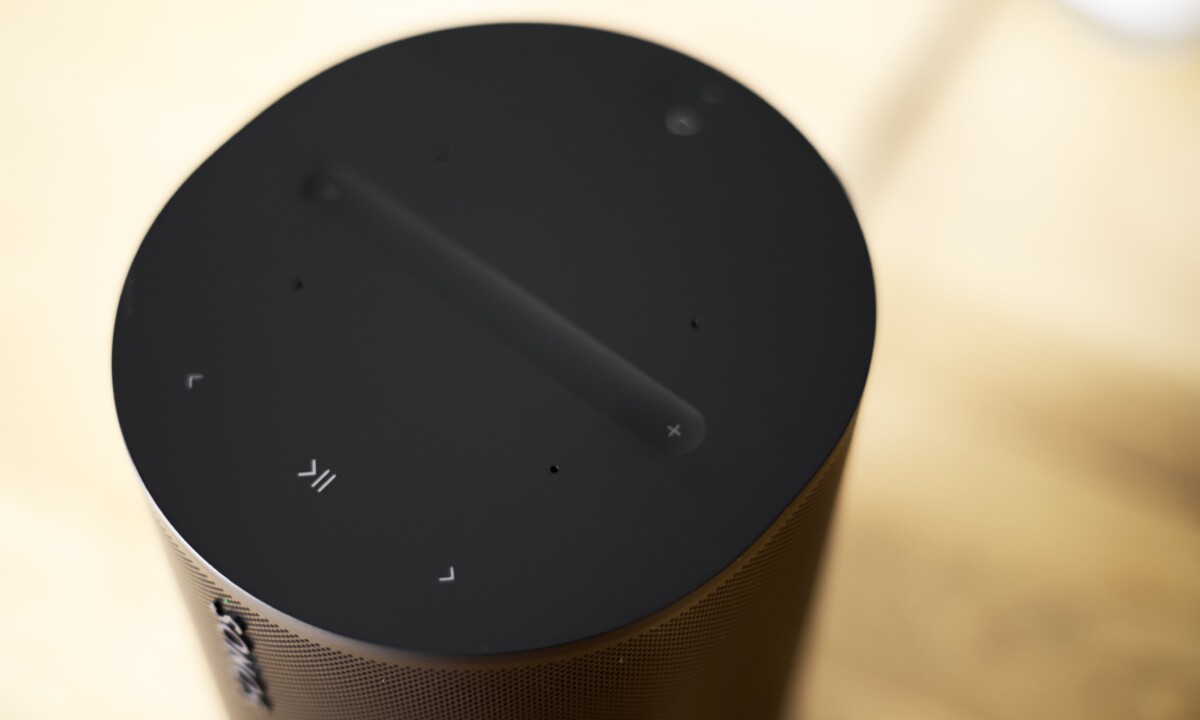
The Era 100 allows users to disable its microphones via a button located at the back instead of a touch-sensitive surface, a good idea that prevents accidentally muting the microphone.
Internal Design of the Era 100
Sonos has not fundamentally changed the internal layout of the Sonos One. The Era 100 is still a 2-way speaker, relying on a woofer-midrange driver directed towards the listening area. Its size has been increased by 25% (now ovoid), which should enable higher sound volume without demanding more power from the amplifier.
Another innovation is the inclusion of two tweeters to expand the soundstage, each oriented in a different direction but also towards the listening area. This is a good idea, allowing Sonos to claim that the Era 100 is a stereo speaker. This is only half true… we’ll get back to that.

There is no passive radiator or bass-reflex port; the speaker has a closed design, a choice that helps limit the lingering of low frequencies and speeds up the transition from one sound to another.
Sonos Era 100 Connectivity
The Sonos Era 100 is equipped with Wi-Fi 6 and Bluetooth 5 controllers, as well as a stereo analog line input. This is a significant improvement compared to previous models, like the Sonos One or Play:1, which lacked Bluetooth connectivity. Now, the speaker can be used outside the Wi-Fi network, albeit with slightly reduced audio quality due to Bluetooth compression.
The Sonos Era 100 is compatible with the AirPlay 2 protocol, which makes it easy to play music from iPhones, iPads, Macs, and Apple TVs. It’s a bit less straightforward with Android smartphones since Google Cast is no longer supported.
However, Sonos has found a workaround by partnering with Deezer, Tidal, and Spotify, enabling their mobile apps to directly play music on the Era 100. Alternatively, users can choose and save their music streaming service (Apple Music, Amazon Music, etc.) directly in the Sonos app and control playback from there.

As for the analog input, it cannot function without an optional cable that Sonos charges an additional €25 for. This 3.5mm female mini-jack to USB-C male cable allows the Sonos Era 100 speaker to play external analog sources such as a portable music player, radio, computer, or even a turntable.
Since Sonos highlights the latter example, it’s essential to note that only turntables with an integrated preamplifier are compatible, and others will require a separate RIAA phono preamplifier. Lastly, the USB-C port does not support an external DAC mode, and connecting a computer does not enable wired digital audio playback.
Sonos Era 100 Usage and Application
Like the Sonos 1, the Sonos Era 100 can be used in a multiroom setup, where multiple speakers simultaneously play different tracks or the same music. This is possible with AirPlay 2 or Sonos technologies.
Using the Sonos app, you can pair two Sonos Era 100 speakers for stereo listening, connect a Sonos Sub or Sonos Sub Mini to a speaker, or even set up a home theater system with one of the manufacturer’s soundbars (Sonos Ray, Sonos Beam, Sonos Arc), two Sonos Era 100 rear surround speakers, and even multiple subwoofers.
Implementation and Acoustic Calibration
The installation of the Sonos Era 100 is guided by the Sonos app for iOS and Android. It’s not complicated; the app immediately detects the speaker and assists the user during the process of connecting to the home Wi-Fi network.
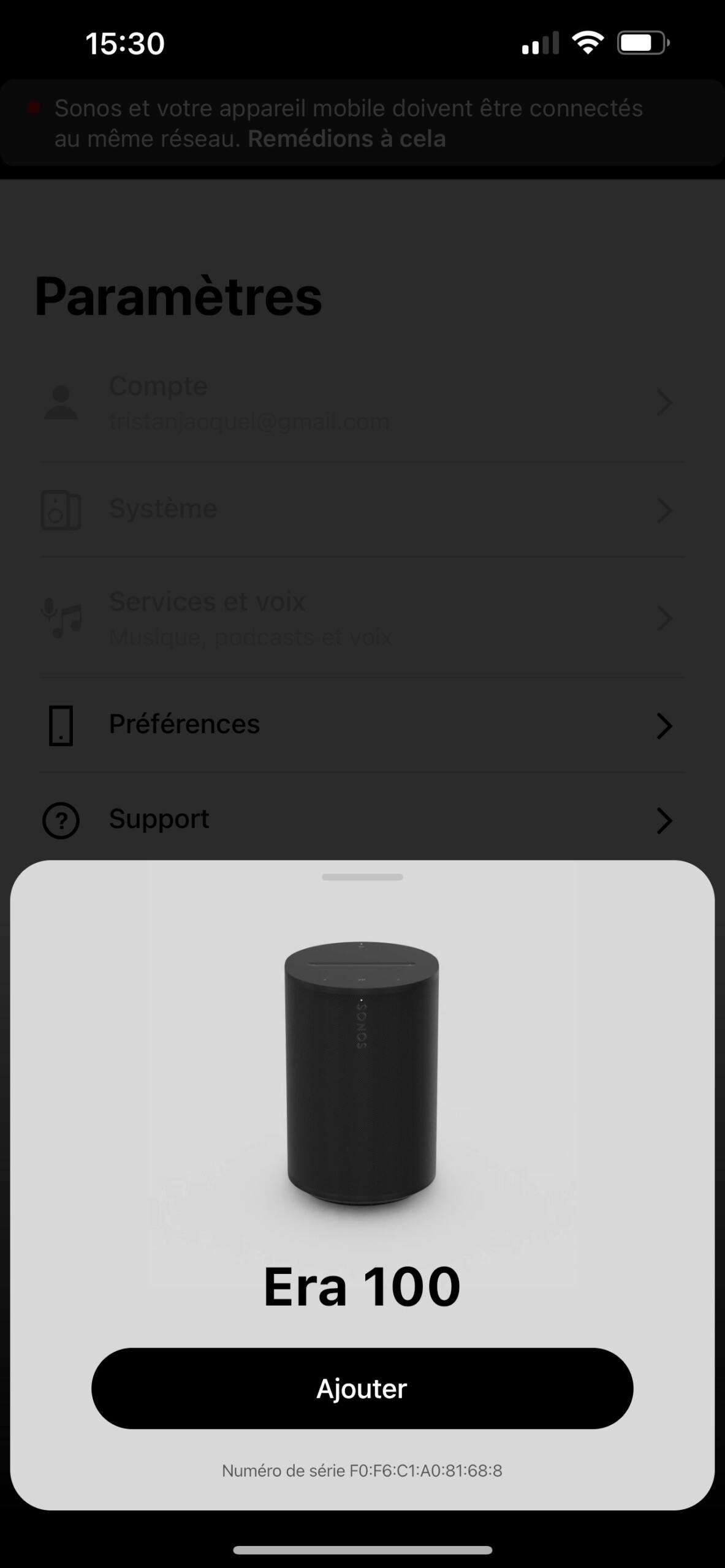
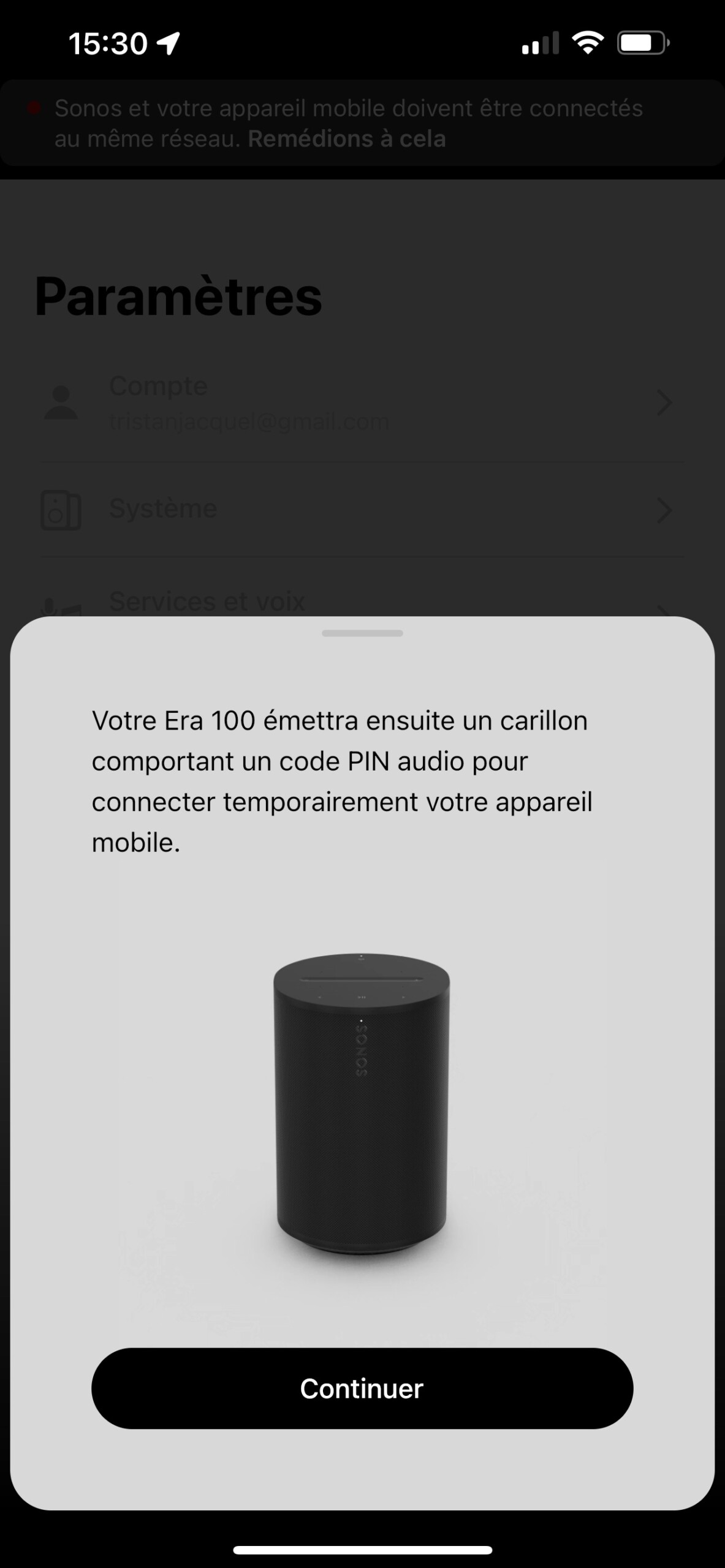

If there is an update available, it will be automatically offered.
After the installation, TruePlay acoustic calibration is offered. The process differs depending on whether you’re using an Android or an iPhone. With Android, the speaker emits a quick series of successive sounds, indicating that it’s calibrated.

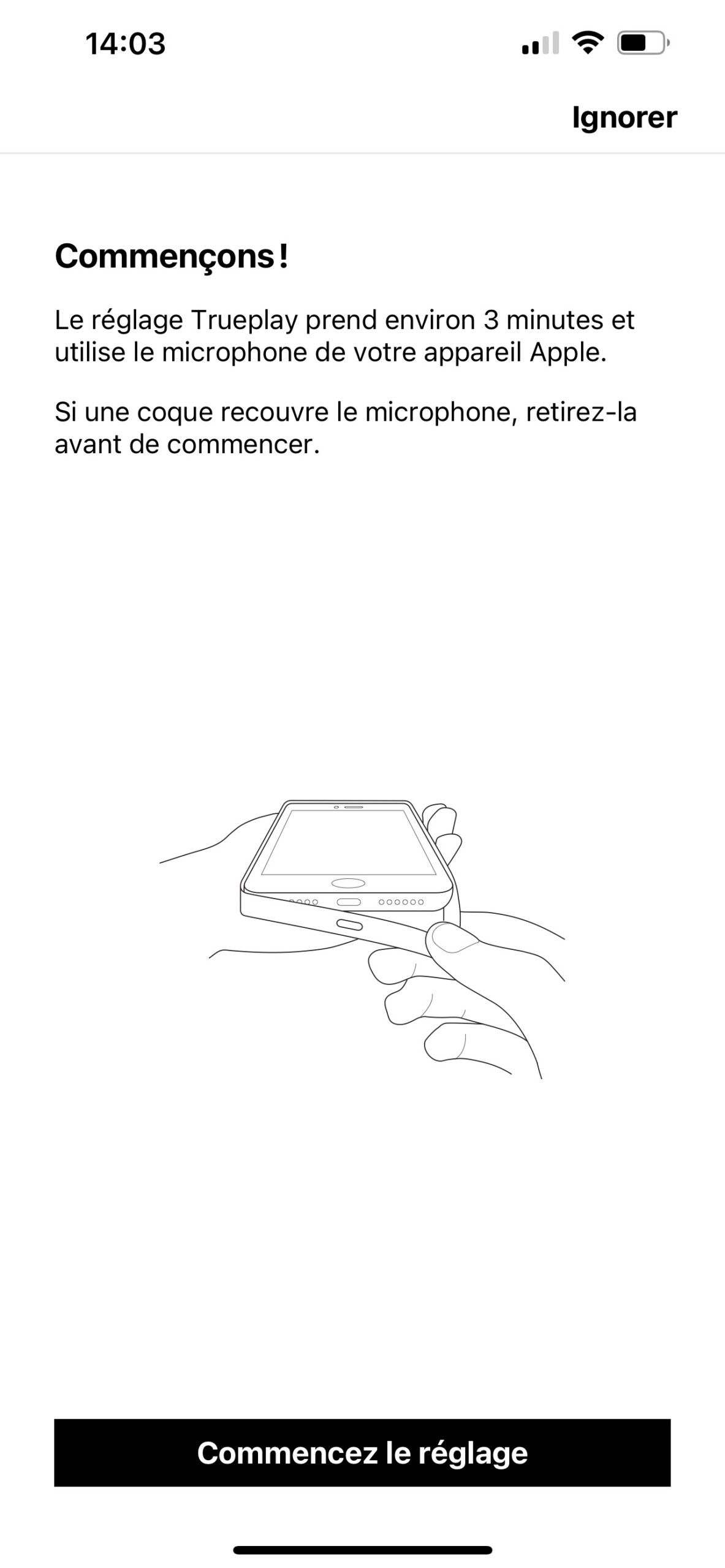

With an iPhone, the calibration takes longer and involves the standardized microphone of the smartphone, as well as the user who needs to walk around the room with the smartphone. We’ll discuss the benefits of this calibration later on.
Two voice assistants to choose from
The speaker can be voice-controlled using two assistants, Alexa or Sonos Voice Control. The latter is limited to selecting music tracks and controlling playback (volume, pause, next track, etc.). To get weather updates or news, you’ll need to choose Alexa.
In practice, the experience is not entirely satisfactory, as the microphones struggle to understand voice commands. You often need to repeat commands and raise your voice, especially in a kitchen where the hood and stove are in use. This is not new, as the Sonos One was already a bit temperamental. On this point, the comparison with the Apple HomePod 2 – which can almost be whispered to – is cruel.

But if you speak confidently, the assistant (Sonos or Alexa) responds quickly to requests. The essential functionality is preserved.
Numerous music services supported
The Sonos ecosystem is compatible with major music streaming services: Amazon Music, Apple Music, Deezer, Tidal, Qobuz, etc. It is also compatible with a myriad of less popular services, including web radios and Sonos Radio, which is handy for listening to French or international radio stations.
Numerous music services are listed in the Sonos app.
UPnP/DLNA home audio servers are also supported from the Sonos app, which is convenient for playing audio files shared on the home network. Plex audio servers are also supported.
Still some performance slowdowns
Sonos announced a 47% faster processor compared to the Sonos One, and indeed, the Sonos Era 100 reacts slightly faster than its predecessor. While the voice assistant’s responses and music launching are faster, there are still some delays in AirPlay 2 playback or when launching a track from the Sonos app. It’s not a deal-breaker, but compared to Apple HomePod, there’s still room for improvement in terms of responsiveness.
Sonos Era 100 Power Consumption
Since the speaker is designed to be constantly powered and always “listening” when called upon, its power consumption must be controlled. The good news is that in standby mode with the assistant functional, the Sonos Era 100 consumes only 2.3 W.
This is a considerable improvement compared to the Sonos One, which required about 3.5 W, but it’s almost two and a half times more than the Apple HomePod 2, which only requires a mere 1 W in standby. At a moderate listening volume for gentle background music, the Era 100 needs only 5 W, and you’ll need to play it very loud to exceed the 10 W mark.
| Mode | Consumption |
|---|---|
| Network Standby (without assistant) | 2 W |
| Network Standby (with assistant) | 2.3 W |
| Active (without music) | 5 W |
| Volume at 25% | 9 W |
| Volume at 50% | 12 W |
| Volume at 75% | 14 W |
| Volume at 100% | 20 W |
Sonos Era 100 Audio
For this test, the Sonos Era 100 was listened to in different rooms (kitchen, living room, bedroom, office) in which it was calibrated. There were few changes after calibration, except for a slight emphasis on the upper bass frequencies. Moreover, between automatic calibration and using the microphone of an iPhone 13 Pro Max, I did not notice any clearly audible differences.
Sound Signature
The Sonos Era 100 is a worthy successor to the One, offering listeners a clearly well-studied and well-balanced sound signature. The bass is generous, its extension is decent considering the speaker’s size, but above all, the midrange — especially vocals — is rendered with great density.
The high frequencies are less directional than with the Sonos One, which improves the width of the soundstage (more on that later). The maximum volume is also noticeably higher, as shown in the curve below.
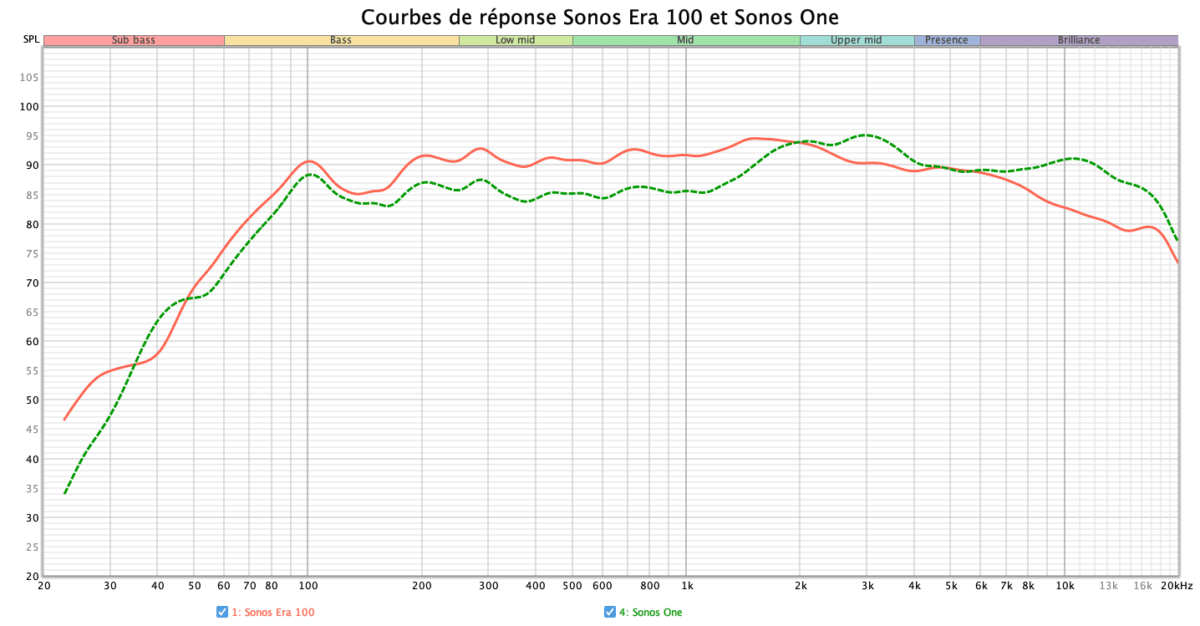
Comparing the response curves of the two speakers, it can be seen that they are almost identical from the infragravity to the midrange, which is impressive considering that the main transducer has changed! This is like acoustic haute couture, or at least the mark of the obvious care taken by Sonos to adhere to a specific sound aesthetic.
The differences in behavior in the treble, although evident on this graph, are largely smoothed out at normal volume. The only real difference lies in the 3kHz bump of the Sonos One, which sometimes gives it a hardness in the midrange, completely eliminated with the Sonos Era 100, which is therefore softer.
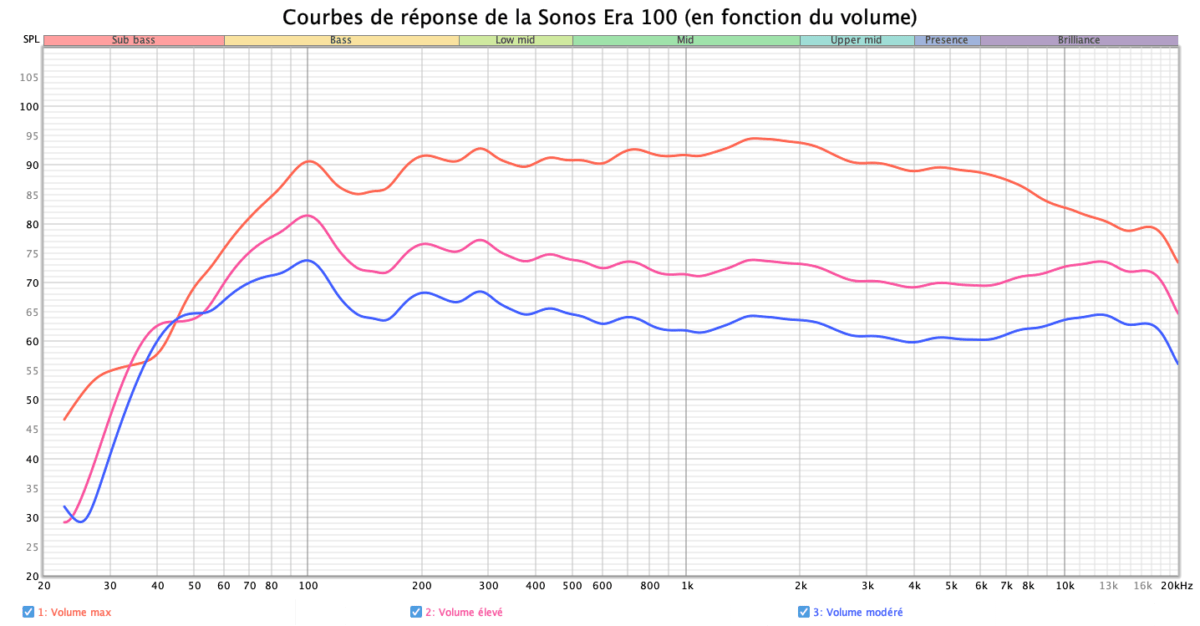
The Sonos Era 100 has a sound signature that varies depending on the listening volume. Sonos has implemented dynamic equalization to enhance the low frequencies at the lowest volume and compensate for the lack of sensitivity of our ears. This bass boost, audible up to about 40% volume (blue curve), is centered around 40-50 Hz, which gives depth to the low sounds. It is automatically reduced as the volume is increased, so as not to exceed the mechanical capabilities of the main transducer or the amplification.
Higher up on the curve, the peak of nervousness at 100 Hz gives impact to percussion (Apple does the same with its latest HomePod), and the accents from 200 to 400 Hz reinforce the presence and details of human voices.
Soundstage and dynamic behavior
Sonos highlights the stereo operation of the Era 100. In practice, this is only half true. Certainly, the speaker is equipped with two tweeters, one oriented slightly to the left and the other to the right, and each one broadcasts a channel.
The sound is therefore indeed stereo, but only in the frequency range played by the tweeter, from 1 kHz to 20 kHz. All lower frequencies, including those of human voices, many strings, and percussion instruments, are broadcast by the 13 cm speaker, either in mono (without any lateralization).

Nevertheless, the Sonos Era 100 performs much better than the Sonos One, whose main flaw is its too marked directivity, and therefore its narrow soundstage. In terms of spatialization, the Era 100 does better and in absolute terms not so bad, because the sound field is slightly wider than with any speaker equipped with a single tweeter. However, the soundstage is less spacious than with the Apple HomePod 2 and its 360° diffusion.
The dynamic behavior of the speaker is satisfactory over the entire volume range, with the bass being faster than on the Sonos One. This can be heard on tracks rich in low frequencies (Massive Attack, The Weeknd, Beyoncé…), but also with jazz where double basses are more lively.
Sonos Era 100 Price
The Sonos Era 100 is available in white or black at a price of $249
Editor’s Verdict
Design
The design features a mix of change and continuity. A new touch-sensitive volume control slider adds convenience, as does a physical button to mute the built-in voice assistant microphones. The build quality is excellent, but the aesthetics are quite traditional.
Software
With the removal of Google Cast, there were concerns that the Sonos Era 100 might be difficult to use on Android devices. However, Sonos has partnered with Deezer, Spotify, and Tidal to enable direct playback from their apps. For other services, users can control them through the Sonos app. Unfortunately, the voice assistant requires speaking louder to activate.
Audio
The Sonos DNA is present, and the Era 100 sounds like a beefed-up Sonos One. It offers more power, a wider soundstage, and a pleasant tonal balance. Vocals are remarkably well-rendered, and the treble is clear.
Overall
Sonos has succeeded! The Sonos Era 100 improves on the One’s performance while maintaining its signature sound. More powerful and spacious, it maintains a balanced sound that’s hard to fault and delivers an enjoyable listening experience. Additionally, the Era 100 now features room-specific auto-calibration.
In terms of functionality, the speaker gains an analog line input but loses Google Assistant and Google Cast support. Users must rely on Alexa for general questions or Sonos Voice Control for music requests and speaker control. For Android streaming, Deezer, Spotify, and Tidal apps detect the speaker and allow for direct use. Overall, the Sonos Era 100 is a reliable choice.
Sonos Era 100 Pros:
- Excellent tonal balance and sound resolution
- Expanded soundstage with two tweeters
- Bluetooth compatibility
- Maximum sound power
- Acoustic calibration
- Voice assistants Alexa and Sonos Voice Control
- Pleasant user experience
- Stereo pairing capability
- Functions as a surround speaker with Sonos soundbars
- Bluetooth and analog line input
- Lower network standby power consumption than the Sonos One
Sonos Era 100 Cons:
- Google Cast and Google Assistant dropped (but alternative solutions in place)
- Moderately sensitive microphones require speaking louder for speaker control
- Optional analog cable

